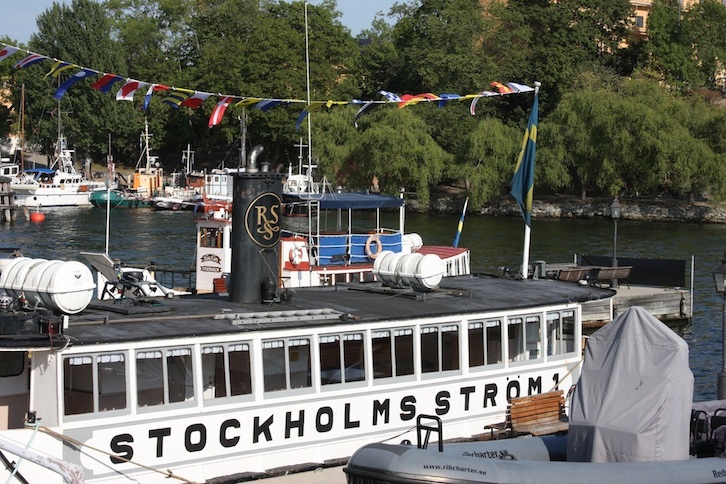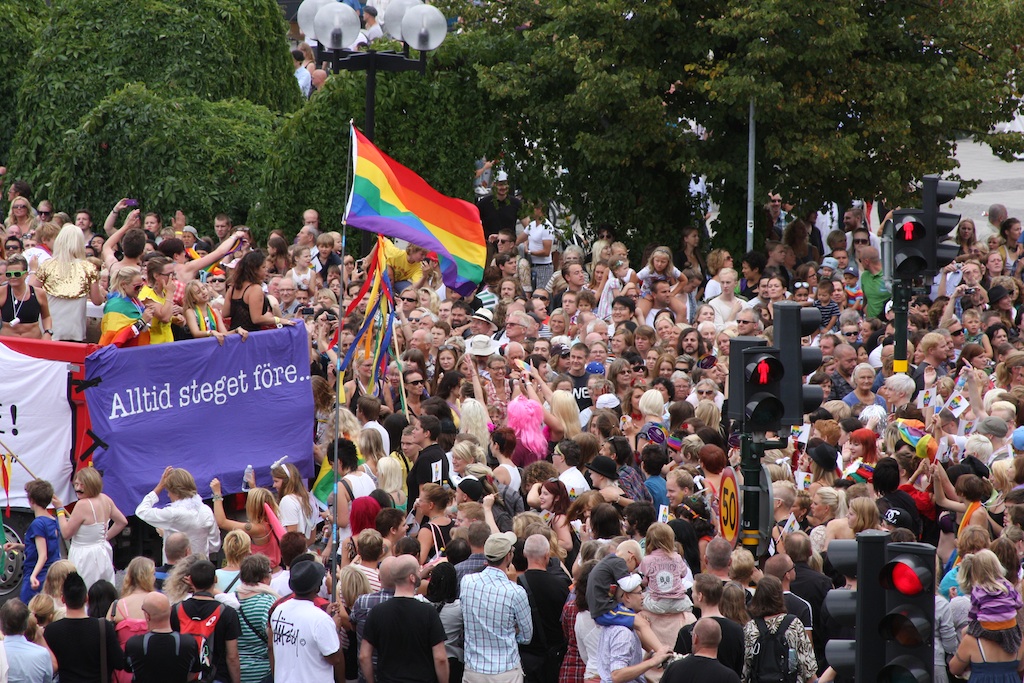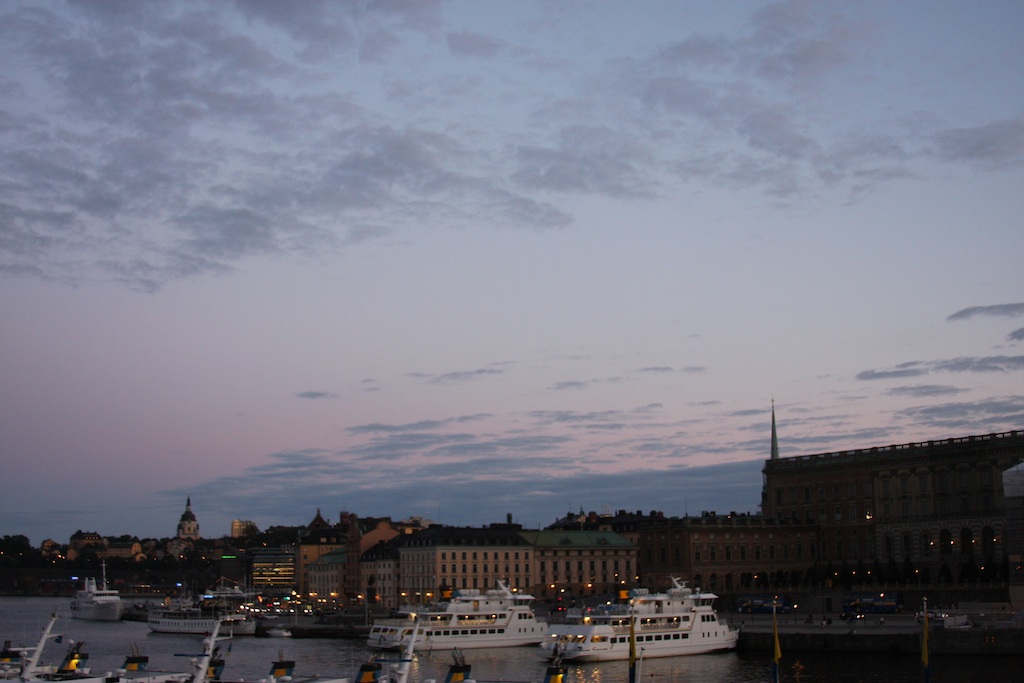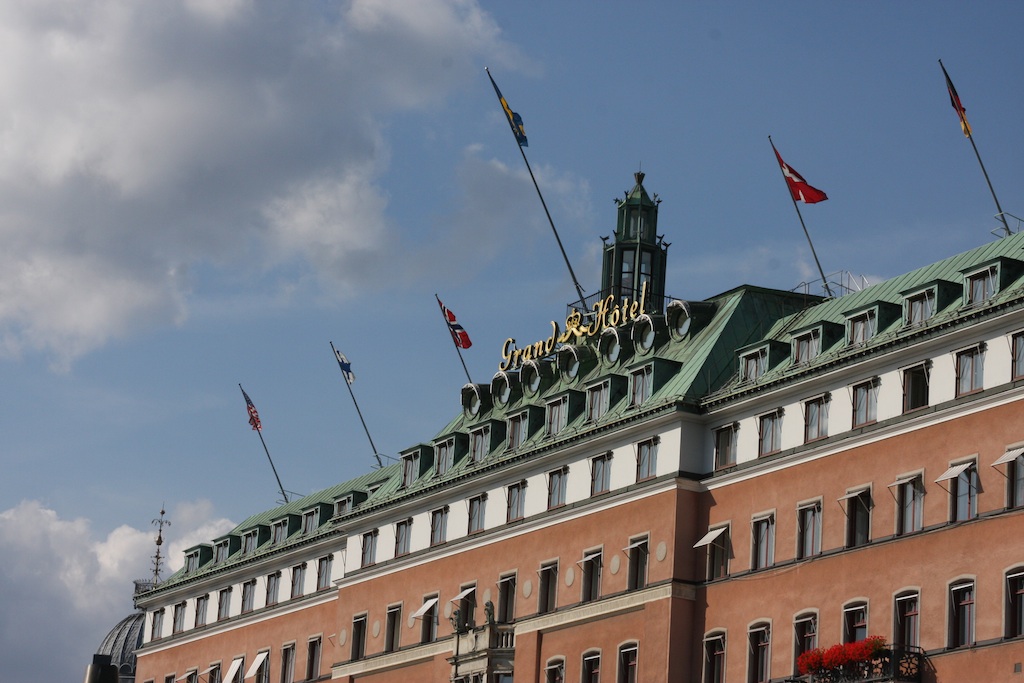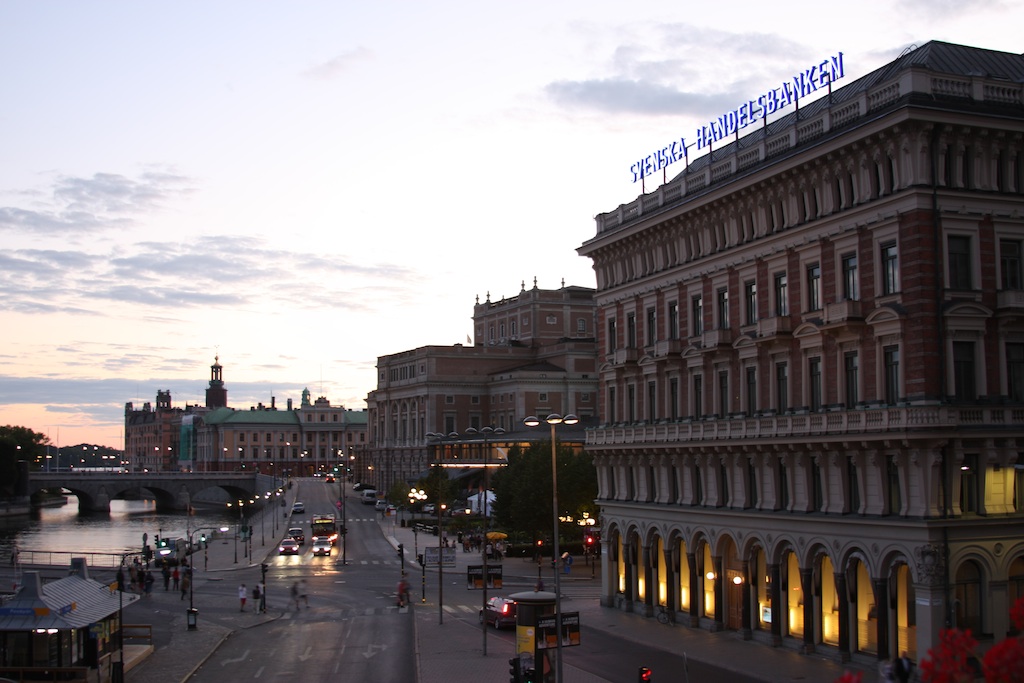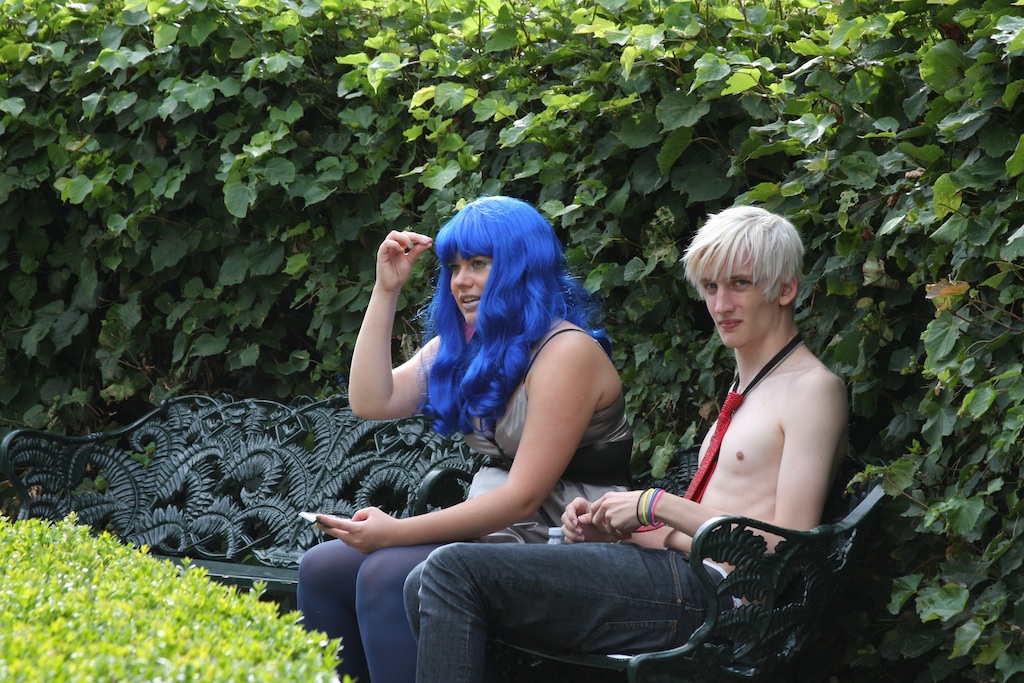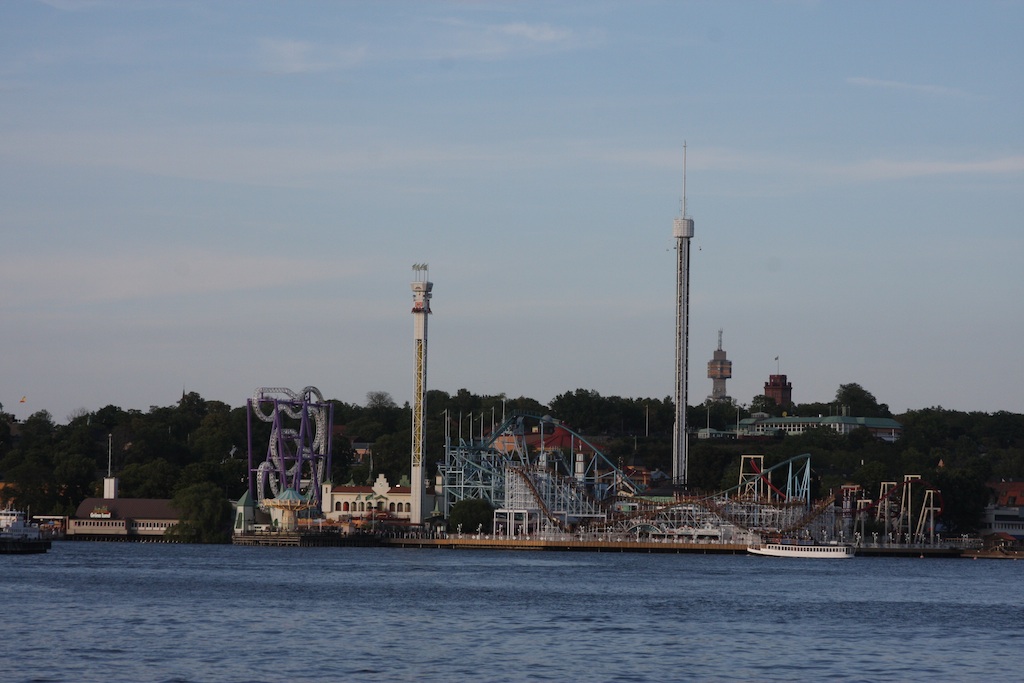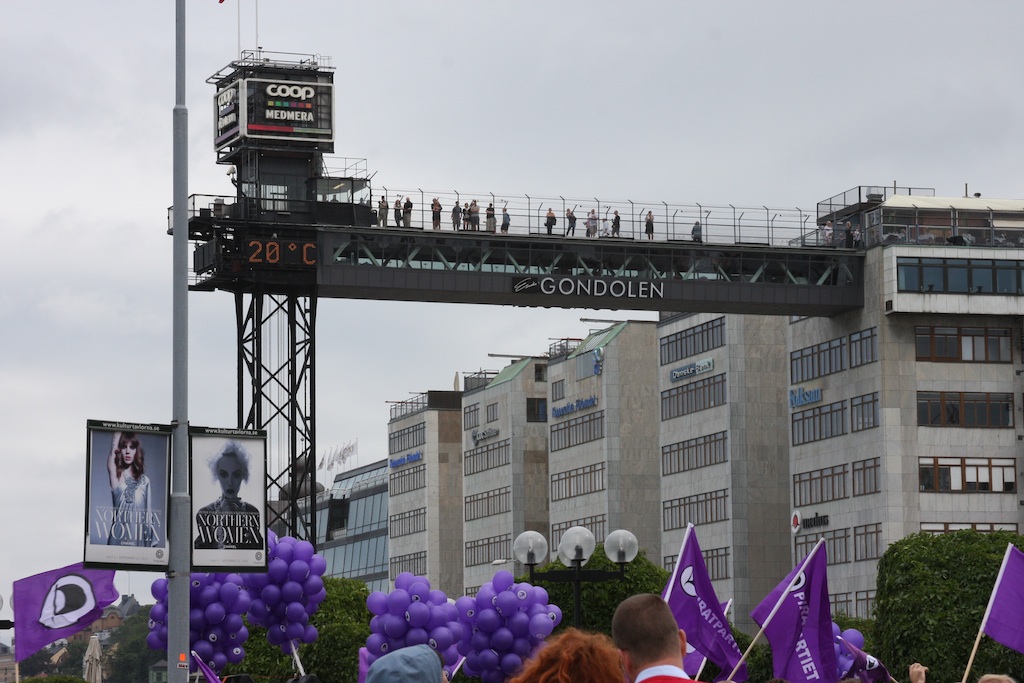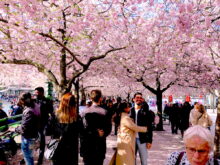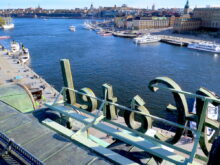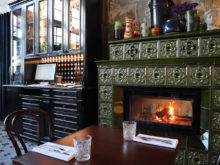Beauty has been, for years, synonymous with Sweden. After all, this is the country that conquered the world with their Nordic models, clothed the globe in H&M fashions, furnished our homes in Ikea – and drowned the world in Absolut. In other words, Swedish beauty conquers all.
Stockholm, one of the world’s most beautiful capitals, is often considered the “Venice of the North” – and to find yourself in the Swedish capital in the midst of Stockholm Pride, the largest LGBT Pride festival in Scandinavia, is to be nearly dumbfounded by the simultaneous visual beauty of both citizenry and city.
Situated on fourteen islands connected by 57 bridges, Stockholm is a feast of stunning waterfront vistas: Lake Malaren to the west – and, to the east, the Baltic Sea, along with more than 30,000 islands, islets, and skerries of the Swedish archipelago. Dating from 1252, the city is more than 750 years old, with Stockholm’s Old Town (Gamla Stan) celebrated as one of Europe’s most beautifully preserved medieval town centers. The largest city in Sweden, Stockholm contains more than 20% of the nation’s nine million citizens – which is perhaps attributable to the city’s more than one hundred museums and over a thousand restaurants.
All through the ten-day Pride festival, rainbow Pride flags fluttered from the bridges of Stockholm and decorated Stockholm’s public buses. One of the more liberal countries of the world, Sweden has a history of secularism that has helped make Stockholm one of Europe’s more cultured destinations for LGBT people. With a history of acceptance, openness, and diversity, Stockholm is often considered the LGBT capital of Scandinavia.
While the United States prepares to celebrate the repeal of “Don’t Ask, Don’t Tell,” it’s instructive to remember that more than thirty years ago, back in 1976, Sweden integrated its entire military, enabling gays to serve without being closeted. And it was in 1979 that Sweden became the first country in the world to declassify homosexuality as a medical disorder, which followed Sweden’s legalization of same-sex sex – way back in 1944. Since 2009, there has been same-sex marriage in Sweden. In short, this is a country that celebrates the beauty of LGBT people.
Stockholmers are a walking testament to their country’s love of fashion and design – and it was telling that signs throughout the city advertised “Northern Women in Chanel,” a photographic exhibition of famous Scandinavian models wearing classic Chanel outfits. Citizens of Stockholm evince an almost intuitive fashion sense, wearing scarves, capes, and hats in shades of Swedish blue and black with an insouciant ease that marries timeless elegance with streamlined modernism.
The city’s contemporary aesthetic is evidenced in locales as illustrious as the Grand Hotel, one of Scandinavia’s most historic residences, where the fabled elegance of the Grand is complemented by the clean lines of 21st-century design and technology. Stockholm’s refined and forward-thinking sensibility often seems the equivalent of wearing a vintage Cartier watch while working on an iPad, resulting in a kind of effortless chic.
Furthermore, Stockholm is green – and environmentally-savvy. Thirty percent of the city is waterways that are traversed by ferries, boats, and ships, with another thirty percent given over to parks and green spaces, which means that Stockholm is as good for the lungs as it is beautiful to photograph. Invariably, the city appears on the indices of the world’s “Most Livable Cities,” and in 2010, Stockholm became the first city to be granted the title of European Green Capital.
As a European magazine correspondent wrote in 1934, “It is true that the Swedes have a natural advantage in looking distinguished and elegant. The girls saunter across the paved paths with a casual and relaxed air, their partners following behind, escorting them to the floor with dexterity and decorum. Say what you will of the young gentlemen of Stockholm, but they certainly can dance.”
What was true in 1934 is equally evident in 2011, where more than 50,000 participants danced in the Pride Parade, along with half a million spectators lining the streets – before arriving in Pride Park at the Royal Gardens for another all-night party. This year’s Pride theme was “Openness,” chosen to highlight an ideal society where people are free to be who they are. At the party at Operaterrassen, all along the outdoor terrace, sexy boys and sylphlike girls lined the 18th-century staircases of Stockholm’s Opera House, drinking and smoking – and looking as casually elegant as their forebears.
And in the light of the moon, with the ebullience of Stockholm Pride ringing all around, it was easy at that moment to believe that nowhere in the world exists a city more beautiful.
What to See:
Fotografiska: Opened in May 2010 and housed along the docks of Stadsgarden in an historic Art Nouveau building from 1906, Fotografiska is one of the world’s largest homes for contemporary photography, encompassing nearly 60,000 square feet of exhibition space. A second-floor bar and restaurant serves regional Swedish fare that is as delicious as the panoramic view of Stockholm – and you might find yourself loitering at table even after a second cup of coffee or another beer. In the summer, the brand-new outdoor terrace is perfect for a glass of bubbly – and particularly as the sun sets, leaving Stockholm a shimmering city of light.
No matter how mesmerizing you find the view, don’t miss the current exhibition on Robert Mapplethorpe. More than twenty years after Mapplethorpe’s incendiary art about New York’s gay scene in the Eighties inflamed members of the United States Congress, it’s instructive to gaze at the work while listening to the audio guide – and to realize anew how the States remains stubbornly puritanical when confronted with the nudity of gay men. Mapplethorpe’s tender portraits of African-American men, gay couples, orchids, and lilies look as provocative and brilliant as ever – and remain a testament to the pursuit of beauty in the face of adversity. Exhibition continues through 2 October 2011.
LINK: Fotografiska
Millesgarden: More than a hundred years ago, newlyweds Carl and Olga Milles purchased property on the cliff of Herserud, high above lake Värtan on the island of Lidingö in Stockholm, with the intent of incorporating their artists’ studios into their home. Designed by architect Carl Bengtsson, the original Millesgården expanded over the years to its current five-acre museum with sculpture gardens, fountains, terraces, studios, and stairways.
The stunning cliffside park and museum evokes the gardens of Italy’s Mediterranean coast – with the addition of snow in the winter rendering the setting even more enchanted. Well-known for his fountains and his commissioned works throughout the States, the celebrated Swedish sculptor Carl Milles was artist in residence and professor at Cranbrook Academy of Art in Michigan from 1931-1950, but it is at Millesgården that the monumental works of Milles seem most at home.
Often naked and somewhat homoerotic, Milles’ sculptures were so often underappreciated in the States that Milles kept a fig leaf maker on retainer. Open to the public since the late Thirties, Millesgården recently finished renovations on the lower terrace fountains, thereby insuring that Milles’ renditions of Jonah and the Whale and Europa remain in the company of the gargantuan Poseidon. Whether you visit in the summer or winter, an afternoon at Millesgården is as romantic as the love story that produced such an idyllic sanctuary.
LINK: Millesgarden
Moderna Museet: Located on the isle of museums called Skeppsholmen, alongside a sculpture garden by Niki de Saint Phalle and Jean Tinguely, Stockholm’s Modern Museum is worth a visit for its setting alone. A waterfront esplanade affords gorgeous views of Stockholm – and, in summer, the charming restaurant is an open-air aerie with harbor views. Of course there’s also the museum’s permanent collection, currently focusing on the art of photography with “Another Story: Photography from the Moderna Museet Collection.” With a collection of more than 100,000 photographs, entire rooms are devoted to the works of Irving Penn, Diane Arbus, Cindy Sherman, Helmut Newton, Man Ray, and nearly every photographer associated with the twentieth century. Plan to spend at least an afternoon – and then indulge in a restorative cocktail at the Hotel Skeppsholmen, just down the hill.
LINK: Moderna Museet
Vasa Museum: You have to see it to believe it, which is, perhaps, one reason why the Vasa Museum is the most visited museum in Scandinavia, with over one million visitors a year – and more than 30 million visitors since the museum opened in 1961. Now embarking upon its 50th anniversary year, the Vasa Museum’s new home was purpose-built in 1990 to house the only preserved 17th-century ship in the world. It was in 1628 that the Vasa commenced her maiden voyage – only to founder twenty minutes after setting sail and, ultimately, sink into Stockholm harbor, where she rested on the seabed for more than 333 years. Start your visit to the Vasa Museum with the 25-minute film (available in sixteen languages) – and then head upstairs to the top floor where you can grasp the immensity of this boat and the feat of engineering that enabled it to be lifted intact from the water. Few other places in the world provide such verisimilitude to 17th-century maritime life – but for 20th-century museum lovers, there’s also a well-stocked shop and a lovely restaurant.
LINK: Vasa Museum
Where to Stay:
Grand Hotel: For many people who visit Stockholm, there’s only the Grand. Madonna, for example. Or Greta Garbo who holed up here, taking her meals in privacy. Charlie Chaplin hosted Ingmar Bergman in his suite. Princess Grace and Prince Rainier arrived with great fanfare. Sarah Bernhardt was welcomed, with her 22-person entourage. And every year, since 1901, the Nobel Laureates are in residence.
Long considered the flagship hotel of Northern Europe, the Grand Hotel opened in 1874 with the King of Sweden on hand to inspect the premises. Built by a Frenchman, Regis Cadier, a former chef to the Russian ambassador, the Grand Hotel has, for more than a century, exemplified Cadier’s motto to “always treat the customer as if he were a king.”
From the moment of arrival at the massive baldachin entrance, doormen and porters are immediately present to insure a gracious introduction to the Grand Hotel’s many pleasures. A bastion of Old World charms and decorum, the Grand Hotel’s lobby, with its royal blue and butter yellow color scheme and its double marble staircase, is a feast for the eyes – and almost immediately, a guest is transported to an age where proper dress and protocol are inherently understood to be a sign of a society’s well-being.
Now celebrating more than 125 years of impeccable service and refined hospitality, the Grand Hotel has been recently renovated to meet the needs of today’s discerning clientele – wireless is available throughout the hotel, as is 24-hour room service, and nearly every television and movie channel – and yet the hotel retains its Belle Epoque elegance at every turn.
Wander down the wide and quiet hallways and into the public areas, and if you’re lucky, you’ll glimpse the Spegelsalen, the “Hall of Mirrors,” inspired by the Galerie des Glaces at Versailles, where the Nobel banquet was held every year from 1901 through 1929.
The Cadier Bar was named one of the world’s top four bars, according to Newsweek – and Mathias Dahlgren’s Michelin-starred and award-winning restaurants, Matsalen (Dining Room) and Matbaren (Food Bar) are located in what was once the Bolinder Palace, which was acquired by the Grand Hotel in 1889 to house Cadier in a 13-room apartment.
Currently, one of the more impressive accommodations is the Princess Lilian Suite, an Art Deco aerie atop the hotel, complete with library, sauna, grand piano, a dining table seating twelve – as well as a sumptuous 12-person screening room that evokes the setting of films such as “The Way We Were.”
Raison d’Etre, the in-house Nordic-Roman spa, is a sanctum sanctorum created by the Leading Spas of the World spa group, which has worked with Four Seasons and Aman Resorts. As a homage to the first Swedish bathing house (founded in 1269), the scent of birch pervades the spa, which highlights Nordic bathing rituals, including sauna, cold water bucket showers, steam, and cold water plunge pools, as well as a luxuriously heated lap pool and whirlpool. The sense of well-being and calm is as therapeutic as the waters – and complemented by a comely and efficient staff that stocks the spa with lingonberry smoothies and ginger teas.
The recent kitchen renovation included the world’s largest stove, weighing in at more than 4,000 pounds, a fact that becomes more understandable when confronting the breakfast smorgasbord on the Grand Hotel’s historic Veranda. Originally, the hotel’s verandas were built annually as a rite of spring and a harbinger of summer – and it was here on the Veranda that Garbo (before she became a hotel hermit) would take her meals.
If you are so lucky to be in residence at the Grand Hotel, breakfast on the Veranda is one of the most appealing experiences the hotel offers. The sumptuous buffet encompasses an entire ancillary room off the Veranda and is the equivalent to entering the most well-stocked larder in all of Stockholm. Nearly everything your palate desires is available, including roasted vegetables and pickled beets, herring and gravlax, passion fruit and melon, brownies and crepes, pastries and tortes, cheeses and meats – and everything so beautifully prepared as to merit a photographic spread in a gourmet magazine.
To eat breakfast at the Veranda at an early hour, while gazing at the Royal Palace across the Norrström is to understand completely the hotel guest who remarked, “As far as I can see, the only difference between me and the King is that he lives on one side of the water – and I on the other.”
Surely, this is a sentiment that has been well understood by the likes of Elizabeth Taylor, Michael Jackson, Albert Einstein, Henry Ford, the Emperor of Brazil, Martin Luther King, Jr., as well as Japanese dignitaries, European magnates, Russian aristocrats on the run from the Revolution, and just about every other luminary who has claimed the Grand Hotel as home, however temporary.
And to be housed in one of the Grand Hotel’s waterfront rooms, with a balcony overlooking the river, is to realize that you might have been ruined for any other style of life hereafter. Rooms at the Grand Hotel are decorated in a classic contemporary Swedish style that evokes Fifties Paris and the celebrated interiors of designer Dorothy Draper. Bathrooms are capacious, with walk-in rain shower and separate full-size bathtub. As for the staff who attend to these accommodations, they are as discreet and thorough as Santa’s elves, insuring that every detail for your comfort is considered – from in-house chocolates on the night table to slippers and turn-down service. Fresh bath linens appear magically and every surface is immaculate.
In short, a stay at the Grand Hotel Stockholm puts you in the company of Albert Einstein, Gary Cooper, and Marlene Dietrich – and when was the last time you walked such hallowed halls. Cross this legendary threshold and make yourself a part of the Grand Hotel’s illustrious history.
LINK: Grand Hotel, Stockholm
Hotel Skeppsholmen: While each of the fourteen isles that comprise Stockholm’s city proper has its attributes, the sylvan Skeppsholmen is, arguably, the city’s most picturesque. With its landscaped walkways and waterfront vistas, Skeppsholmen is the equivalent of an island park, surrounded by the city – and the Hotel Skeppsholmen perfectly complements the isle’s restorative serenity.
Opened in October 2009 in two structures from 1699, the Hotel Skeppsholmen takes up the entire “Long Row” of houses that originally housed the Royal Marines. Built from the ruins of Swedish castles, the structures were added to Sweden’s historic buildings register in 1935. Given the buildings’ cultural significance (dignitaries and emissaries were often in residence), the hotel’s resultant renovations are both respectful and innovative, using original floorboards and bricks, as well as other recycled materials. Each of the hotel’s 81 capacious rooms is named for a celebrated individual who resided there – albeit before the addition of such modern touches as 37-inch flat-screen TVs with DVDs, minibars, closet safety boxes, and bathrooms with beautiful Boffi basins and artfully-illuminated rain showers.
A member of Design Hotels, Hotel Skeppsholmen was designed by Claesson Kolvisto Rune (Venice Biennale, 2004) – and the rooms reflect that blissful contemplative state that often results from a waterfront setting. With customized furnishings such as writing desks, each room also features modern chairs and pleasing lighting (as well as wireless Internet). Yet it is the views from the hotel’s large windows that prove most enchanting – and make it difficult to leave the premises.
The Skeppsholmen regards itself as an “urban oasis,” a claim that is further substantiated by its cultural neighbors: the Museum of Modern Art, the Swedish Museum of Architecture, the Museum of Far Eastern Antiquities, and a garden of sculpture by Niki de Saint Phalle. You could easily spend your time in Stockholm without stepping foot off Skeppsholmen – and not feel at all badly for doing so. A true cultural oasis, the Hotel Skeppsholmen is as hot as it is cool – and it’s no surprise that the Skeppsholmen is listed on the Condé Nast Traveler 2010 Hot List.
The hotel’s dining rooms showcase the Swedish brand of conviviality known as “Social Dining,” whereby locals and guests commingle over the best of Swedish cuisine. Breakfasts are copious – and relaxed; you could easily remain at table for hours, gazing onto the waterfront and the Skating Pavilion, which was built in 1882 by the Royal Skating Club and the Yacht Club (and which is one reason why the in-house toiletries by Byredo are slightly redolent of chocolate: in honor of the hot chocolate annually served to the Swedish King at the pavilion).
In winter, the grounds of the Skeppsholmen are a winter wonderland of snow-covered trees and white-shrouded statuary. Six months later, in the middle of summer, the idyllic setting is one that begs for its own George Seurat painting. With its al fresco terrace for dining, and tennis courts along the water, and its splendid views of central Stockholm, the Skeppsholmen is a true urban resort.
Managed by the delightful Joachim Olausson, the Skeppsholmen is a proud member of the IGLTA. Register at the Hotel Skeppsholmen and you might find yourself considering a permanent relocation to Stockholm.
LINK: Hotel Skeppsholmen
Hilton Slussen: Centrally located on the island of Södermalm, the Hilton Stockholm Slussen is within easy walking distance to Gamla Stan (Old Town), as well as NK, Stockholm’s premier department store – and a quick five-minute cab from Central Station, where the Arlanda Express runs to the airport every fifteen minutes.
Many of the Slussen’s guest rooms offer lovely water views of Stockholm’s firth, the Riddarfjärden. Furnished in a contemporary Swedish style with ergonomic chairs and marble bathrooms, the rooms feature blond and dark woods (often alternating) to create havens of cool during the summer and warmth during the winter. A fitness room and solarium, as well as Executive Lounge, make this a perfect locale for anyone visiting Stockholm on business.
LINK: Hilton Slussen
Where to Eat:
Mälarpaviljongen: A stunning waterfront oasis, this floating outdoor lounge and restaurant is run by those fabulous boys who brought you riotous fun and glorious food at Torget. During the past decade, this stylish team of restaurateurs have opened a series of chic and très gay establishments in Stockholm – and their latest venture is brilliantly located on a barge, pier, and beach along the shores of Riddarfjärden (aka, the Knight Firth), a bay of Lake Malaren in central Stockholm.
While the views across the bay are Hollywood-perfect, there’s also the seriously gorgeous crowd that gathers nightly at this summer establishment for some of the most delicious organic food. With a profusion of flowers and trees, all surrounded by the azure bay, the setting is unbeatable – and particularly at sunset when lights flicker on the water. If you’re truly blessed, you’ll take dinner in the original Mälarpaviljongen, an enchanted 19th-century Swedish pavilion. Open during the summer only, Mälarpaviljongen is evocative of a beloved summer resort establishment – where memories and magic are made all summer long.
LINK: Mälarpaviljongen
Berns Asian: Founded by renowed pastry chef and entrepreneur Robert Berns in 1863, the Berns Hotel has been a fixture on Berzelii Park in central Stockholm for more than a century. The hotel’s stately salon, Stora Salongen, is a stunning two-story room with multiple chandeliers, massive mirrors, full-size windows onto the park, and enough gilding to fund a small country. With a long history as a fabled supper club, the room has hosted performances by Liza Minnelli, Sinatra, Dietrich, Josephine Baker, and scores of other illustrious entertainers (as well as parties during Stockholm Pride week).
Currently, Berns Asian occupies the historic, 500-capacity room – and the Asian fusion restaurant does a laudable job serving food that can be as interesting as the room’s provenance. From Singapore street food to Yum Cha (Chinese afternoon tea), Berns Asian covers a broad swath of Asian cuisine. In a room this grand and capacious, it takes a good deal to take your eyes off the deluxe surroundings – and yet, Berns Asian insures that you care as much about what you’re eating as what you’re seeing. Keep your camera within reach; this restaurant looks gorgeous in photographs.
LINK: Berns Asian
Eken Matsal @ Hilton Stockholm Slussen: With a stylish outdoor bar during summer, Eken Matsal, one of the Hilton Stockholm Slussen’s two restaurants, is the epitome of its dress code: smart and casual. The international menu highlights Swedish specialties, as well as global comfort food, and the eco-friendly design complements the restaurant’s savvy clientele. Whether you’re visiting for cocktails, brunch, or dinner, the atmosphere is cool and comfortable.
LINK: Eken Matsal @ Hilton Stockholm Slussen
Getting There:
SAS Airlines: SAS Airlines flies direct from Newark to Stockholm’s Arlanda Airport with a crew that is both professional and fun-loving as evidenced by last year’s “Love Is In the Air” flight, where the entire crew serenaded two newlywed LGBT couples with their own version of “I Am What I Am” before serving wedding cake.
SAS Business Class is truly deluxe, with a self-massaging chair that’s more comfortable than many beds. Business Class bathrooms have windows – as well as fresh flowers and linens, and meal service in Business showcases a smorgasbord of Swedish cuisine with tablecloths, cutlery, and copious amounts of alcohol, should you desire.
Even SAS Economy Extra is an exceptional way to fly to or from Stockholm, including the requisite comfort kit, full meals, plenty of wine, plush duvets, and enough leg and arm space to keep you flexible throughout the flight.
Best of all, the entire SAS crew wants you to be comfortable and they work to keep you happy – with treats like gelato and sorbet, chocolates, and plenty of sexy Swedish smiles.
LINK: SAS Scandinavian Airlines
Arlanda Express: To ride this sleek, streamlined yellow-and-gray train from Stockholm’s Central Station to Stockholm-Arlanda Airport is to bemoan the state of mass transit in the United States. Why, oh why can’t the major cities of the States have a train to the airport this modern and efficient? The twenty-minute journey from Stockholm City to the Stockholm-Arlanda Airport is also the most environmentally friendly way to travel, thanks to trains that run on electricity from renewable sources. Furthermore, the train is as punctual as a Swiss, with trains departing at least four times every hour. As for the trains themselves, they are so comfortable and stylish (imagine magnetized window blinds, photo walls, ergonomic seating – and a lounge) that you’re almost sorry that the journey to the airport has ended. Now, really, when was the last time you felt like that on your way to an airport? In all honesty, this is quite possibly the smoothest, most stress-free journey to the airport we’ve ever experienced. It’s no wonder that Arlanda Express has more than three million annual riders.
LINK: Arlanda Express
LGBT Stockholm Information:
The Stockholm Gay & Lesbian Network was formed by Stockholm Visitors Board in 2005 with the purpose of working closely with the travel industry to insure that LGBT visitors know about Stockholm’s traditions of openness and diversity.
The Stockholm Gay & Lesbian Network functions as a network-based partnership that works closely with VisitSweden and special interest organizations such as Stockholm Gay Life, QX, and Stockholm Pride.
The network is also active within international organizations such as IGLTA (the International Gay & Lesbian Travel Association) and CMI (Community Marketing), while also attending international trade fairs and conferences. For the latest updates, news, and events on LGBT Stockholm, visit the Stockholm Gay & Lesbian Network.
LINKS:
Click here for MRNY slideshow of Stockholm in summer
Stockholm Gay & Lesbian Network
Click here for the latest updates, news, and events on Visit Stockholm’s LGBT Stockholm blog.
Click here to follow Stockholm on Facebook.

